Synchrotron Radiation Pair Distribution Function Analysis of Gels in Cements
Abstract
:1. Introduction
1.1. Cements
1.2. X-ray Pair Distribution Function Analysis
2. Results and Discussion
2.1. Alite Pastes
2.2. Calcium Aluminate Pastes
2.3. Ye’elimite with Gypsum Paste
3. General Discussion
4. Materials and Methods
4.1. Sample Preparation
- (a)
- Tricalcium silicate, alite, has been purchased from Mineral Research Processing (M.R.PRO). Alite was hydrated at different w/s mass ratios, 0.46, 0.55, 0.65, and 0.80, for 34 days at room temperature.
- (b)
- Calcium aluminate, CaAl2O4, was prepared as previously reported [32]. This sample was hydrated at a w/s ratio of 0.55 and 1.20, at 35 °C for 30 days. Moreover, to study the influence of the temperature, the sample with a w/s ratio of 0.55 was also hydrated at 45 °C.
- (c)
- Ye’elimite was synthetized as previously reported [40]. Ye’elimite was mixed with the stoichiometric amount of gypsum according to reaction (3), and the mixture was hydrated at a w/s ratio of 1.2 for 21 days at room temperature. A second sample was prepared by mixing ye’elimite with bassanite, instead of gypsum, also at a w/s ratio of 1.2 for 14 days. In this case, the bassanite dosage was an excess of 18% with respect to the theoretical amount needed to yield ettringite.
4.2. Particle Size Distribution (PSD)
4.3. Thermal Analysis
4.4. Synchrotron X-ray Powder Diffraction (SXRPD)
4.5. Laboratory X-ray Powder Diffraction (LXRPD) with Internal Standard
4.6. Rietveld Data Analysis
4.7. PDF Data Analysis
Supplementary Materials
Acknowledgments
Author Contributions
Conflicts of Interest
References
- Ludwig, H.M.; Zhang, W. Research review of cement clinker chemistry. Cem. Concr. Res. 2015, 78, 24–37. [Google Scholar] [CrossRef]
- Taylor, H.F.W. Cement Chemistry; Thomas Telford: London, UK, 1997; ISBN 978-0727725929. [Google Scholar]
- Scrivener, K.L.; Juilland, P.; Monteiro, P.J.M. Advances in understanding hydration of portland cement. Cem. Concr. Res. 2015, 78, 38–56. [Google Scholar] [CrossRef]
- Aranda, M.A.G.; De la Torre, A.G.; León-Reina, L. Rietveld quantitative phase analysis of OPC clinkers, cements and hydration products. Rev. Mineral. Geochem. 2012, 74, 169–209. [Google Scholar] [CrossRef]
- Thomas, J.J.; Jenning, H.M.; Allen, A.J. Relationships between composition and density of tobermorite, jennite, and nanoscale CaO−SiO2−H2O. J. Phys. Chem. C 2010, 114, 7594–7601. [Google Scholar] [CrossRef]
- Chen, J.J.; Sorelli, L.; Vandamme, M.; Ulm, F.J.; Chanvillard, G.J. A coupled nanoindentation/SEM-EDS study on low water/cement ratio portland cement paste: Evidence for C–S–H/Ca(OH)2 nanocomposites. Am. Cer. Soc. 2010, 93, 1484–1493. [Google Scholar] [CrossRef] [Green Version]
- Allen, A.J.; Thomas, J.J.; Jennings, H.M. Composition and density of nanoscale calcium-silicate-hydrate in cement. Nat. Mater. 2007, 6, 311–316. [Google Scholar] [CrossRef] [PubMed]
- Pustovgar, E.; Sangodkar, R.P.; Andreev, A.S.; Palacios, M.; Chmelka, B.F.; Flatt, R.J.; d’Espinose de Lacaillerie, J.-B. Understanding silicate hydration from quantitative analyses of hydrating tricalcium silicates. Nat. Commun. 2016, 10952, 1–9. [Google Scholar] [CrossRef] [PubMed]
- Richardson, I.G. Model structures for C-(A)-S-H(I). Acta Cryst. B 2014, 70, 903–923. [Google Scholar] [CrossRef] [PubMed]
- Palkovic, S.D.; Brommer, D.B.; Kupwade-Patil, K.; Masic, A.; Buehler, M.J.; Büyüköztürk, O. Roadmap across the mesoscale for durable and sustainable cement paste—A bioinspired approach. Constr. Build. Mater. 2016, 115, 13–31. [Google Scholar] [CrossRef]
- Papatzani, S.; Paine, K.; Calabria-Holley, J. A comprehensive review of the models on the nanostructure of calcium silicate hydrates. Constr. Build. Mater. 2015, 74, 219–234. [Google Scholar] [CrossRef]
- Dharmawardhana, C.C.; Misra, A.; Ching, W.-Y. Quantum mechanical metric for internal cohesion in cement crystals. Sci. Rep. 2014, 7332, 1–8. [Google Scholar] [CrossRef] [PubMed]
- Grangeon, S.; Fernandez-Martinez, A.; Baronnet, A.; Marty, N.; Poulain, A.; Elkaïm, E.; Roosz, C.; Gaboreau, S.; Henocq, P.; Claret, F. Quantitative X-ray pair distribution function analysis of nanocrystalline calcium silicate hydrates: A contribution to the understanding of cement chemistry. J. Appl. Cryst. 2017, 50, 1–8. [Google Scholar] [CrossRef] [PubMed]
- Muller, A.C.A.; Scrivener, K.L.; Gajewicz, A.M.; McDonald, P.J. Densification of C–S–H measured by 1H NMR relaxometry. J. Phys. Chem. C 2013, 117, 403–412. [Google Scholar] [CrossRef]
- Rejmak, P.; Dolado, J.S.; Stott, M.J.; Ayuela, A. 29Si chemical shift anisotropies in hydrated calcium silicates: A computational study. J. Phys. Chem. C 2013, 117, 8374–8380. [Google Scholar] [CrossRef]
- Thomas, J.J.; Chen, J.J.; Jennings, H.M.; Neumann, D.A. Ca−OH bonding in the C−S−H gel phase of tricalcium silicate and white Portland cement pastes measured by inelastic neutron scattering. Chem. Mater. 2003, 15, 3813–3817. [Google Scholar] [CrossRef]
- Gartner, E.; Maruyana, I.; Chen, J. A new model for the C-S-H phase formed during the hydration of Portland cements. Cem. Concr. Res. 2017, 97, 95–106. [Google Scholar] [CrossRef]
- Pöllmann, H. Calcium aluminate cements—Raw materials, differences, hydration and properties. Rev. Mineral. Geochem. 2012, 74, 1–82. [Google Scholar] [CrossRef]
- Aranda, M.A.G.; De la Torre, A.G. Sulfoaluminate cement. In Eco-Efficient Concrete; Pacheco-Torgal, F., Jalali, S., Labrincha, J., Eds.; Woodhead Publishing: Cambridge, UK, 2013; pp. 488–522. [Google Scholar]
- Cuesta, A.; Álvarez-Pinazo, G.; Sanfélix, S.G.; Peral, I.; Aranda, M.A.G.; De la Torre, A.G. Hydration mechanisms of two polymorphs of synthetic ye’elimite. Cem. Concr. Res. 2014, 63, 127–136. [Google Scholar] [CrossRef]
- Egami, T.; Billinge, S.J.L. Underneath the Bragg-Peaks: Structural Analysis of Complex Materials, 2nd ed.; Elsevier: Amsterdam, The Netherlands, 2012. [Google Scholar]
- Billinge, S.J.L.; Kanatzidis, M.G. Beyond crystallography: The study of disorder, nanocrystallinity and crystallographically challenged materials with pair distribution functions. Chem. Commun. 2004, 7, 749–760. [Google Scholar] [CrossRef] [PubMed]
- Proffen, T.; Page, K.L.; McLain, S.E.; Clausen, B.; Darling, T.W.; TenCate, J.A.; Lee, S.-Y.; Ustundag, E. Atomic pair distribution function analysis of materials containing crystalline and amorphous phases. Z. Kristallogr. 2005, 220, 1002–1008. [Google Scholar] [CrossRef]
- Davis, T.; Johnson, M.; Billinge, S.J.L. Towards phase quantification at the nanoscale using the total scattering pair distribution function (TSPDF) method: Recrystallization of cryomilled sulfamerazine. Cryst. Growth Des. 2013, 13, 4239–4244. [Google Scholar] [CrossRef]
- Aranda, M.A.G. Recent studies of cements and concretes by synchrotron radiation crystallographic and cognate methods. Crystallgr. Rev. 2016, 22, 150–196. [Google Scholar] [CrossRef]
- Meral, C.; Benmore, C.J.; Monteiro, P.J.M. The study of disorder and nanocrystallinity in C-S-H, supplementary cementitious materials and geopolymers using pair distribution function analysis. Cem. Concr. Res. 2011, 41, 696–710. [Google Scholar] [CrossRef]
- Soyer-Uzun, S.; Chae, S.R.; Benmore, C.J.; Wenk, H.-R.; Monteiro, P.J.M. Compositional evolution of calcium silicate hydrate (C-S-H) structures by total X-ray scattering. J. Am. Ceram. Soc. 2012, 95, 793–798. [Google Scholar] [CrossRef]
- Morandeau, A.E.; White, C.E. In situ X-ray pair distribution function analysis of accelerated carbonation of a synthetic calcium–silicate–hydrate gel. J. Mater. Chem. A 2015, 3, 8597–8605. [Google Scholar] [CrossRef]
- Skinner, L.B.; Chae, S.R.; Benmore, C.J.; Wenk, H.R.; Monteiro, P.J.M. Nanostructure of calcium silicate hydrates in cements. Phys. Rev. Lett. 2010, 104, 1–4. [Google Scholar] [CrossRef] [PubMed]
- White, C.E. Effects of temperature on the atomic structure of synthetic calcium-silicate-deuterate gels: A neutron pair distribution function investigation. Cem. Conc. Res. 2015, 79, 93–100. [Google Scholar] [CrossRef]
- White, C.E.; Daemen, L.L.; Monika, H.; Page, K. Intrinsic differences in atomic ordering of calcium (alumino)silicate hydrates in conventional and alkali-activated cements. Cem. Concr. Res. 2015, 67, 66–73. [Google Scholar] [CrossRef]
- Cuesta, A.; Ichikawa, R.U.; Londono-Zuluaga, D.; De la Torre, A.G.; Santacruz, I.; Turrillas, X.; Aranda, M.A.G. Aluminum hydroxide gel characterization within a calcium aluminate cement paste by combined pair distribution function and Rietveld analyses. Cem. Concr. Res. 2017, 96, 1–12. [Google Scholar] [CrossRef]
- Bergold, S.T.; Goetz-Neunhoeffer, F.; Neubauer, J. Mechanically activated alite: New insights into alite hydration. Cem. Concr. Res. 2015, 76, 202–211. [Google Scholar] [CrossRef]
- Masoero, E.; Thomas, J.J.; Jennings, H.M. A reaction one hypothesis for the effects of particle size and water-to-cement ratio on the early hydration kinetics of C3S. J. Am. Ceram. Soc. 2014, 97, 967–975. [Google Scholar] [CrossRef]
- De la Torre, A.G.; Bruque, S.; Campo, J.; Aranda, M.A.G. The superstructure of C3S from synchrotron and neutron powder diffraction and its role in quantitative phase analyses. Cem. Concr. Res. 2002, 32, 1347–1356. [Google Scholar] [CrossRef]
- Chaix-Pluchery, O.; Pannetier, J.; Bouillot, J.; Niepce, J.C. Structural prereactional transformations in Ca(OH)2. J. Solid State Chem. 1987, 67, 225–234. [Google Scholar] [CrossRef]
- Zhang, J.; Scherer, W. Comparison of methods for arresting hydration of cements. Cem. Concr. Res. 2011, 41, 1024–1036. [Google Scholar] [CrossRef]
- Cuesta, A.; De la Torre, A.G.; Santacruz, I.; Trtik, P.; da Silva, J.; Diaz, A.; Holler, M.; Aranda, M.A.G. Chemistry and mass density of aluminum hydroxide gel in eco-cements by ptychographic x-ray computed tomography. J. Phys. Chem. C. 2017, 121, 3044–3054. [Google Scholar] [CrossRef]
- Jennings, H.M. Refinements to colloid model of C-S-H in cement: CM-II. Cem. Concr. Res. 2008, 38, 275–289. [Google Scholar] [CrossRef]
- Cuesta, A.; De La Torre, A.G.; Ramirez-Losilla, E.; Peterson, V.K.; Rejmak, P.; Ayuela, A.; Frontera, C.; Aranda, M.A.G. Structure, atomistic simulations, and phase transition of stoichiometric yeelimite. Chem. Mater. 2013, 25, 1680–1687. [Google Scholar] [CrossRef]
- García-Mate, M.; De la Torre, A.G.; Leon-Reina, L.; Aranda, M.A.G.; Santacruz, I. Hydration studies of calcium sulfoaluminate cements blended with fly ash. Cem. Concr. Res. 2013, 54, 12–20. [Google Scholar] [CrossRef]
- Fauth, F.; Peral, I.; Popescu, C.; Knapp, M. The new material science powder diffraction beamline at ALBA synchrotron. Powder Diffr. 2013, 28, S360–S370. [Google Scholar] [CrossRef]
- Larson, A.C.; Von Dreele, R.B. General structure analysis system (GSAS). Los Alamos national laboratory report LAUR. 2000; 86–748. [Google Scholar]
- De la Torre, A.G.; Bruque, S.; Aranda, M.A.G. Rietveld quantitative amorphous content analysis. J. Appl. Crystallogr. 2001, 34, 196–202. [Google Scholar] [CrossRef]
- Juhàs, P.; Davis, T.; Farrow, C.L.; Billinge, S.J.L. PDFgetX3: A rapid and highly automatable program for processing powder diffraction data into total scattering pair distribution functions. J. Appl. Crystallogr. 2013, 46, 560–566. [Google Scholar] [CrossRef]
- Farrow, C.L.; Juhás, P.; Liu, J.; Bryndin, D.; Božin, E.S.; Bloch, J.; Proffen, T.; Billinge, S.J.L. PDFfit2 and PDFgui: Computer programs for studying nanostructure in crystals. J. Phys. Condens. Matter 2007, 19, 335219. [Google Scholar] [CrossRef] [PubMed]
- Jeong, I.-K.; Proffen, T.; Mohiuddin-Jacobs, F.; Billinge, S.J.L. Measuring correlated atomic motion using X-ray diffraction. J. Phys. Chem. A 1999, 103, 921–924. [Google Scholar] [CrossRef]
- Jeong, I.-K.; Heffner, R.H.; Graf, M.J.; Billinge, S.J.L. Lattice dynamics and correlated atomic motion from the atomic pair distribution function. Phys. Rev. B 2003, 67, 104301. [Google Scholar] [CrossRef]
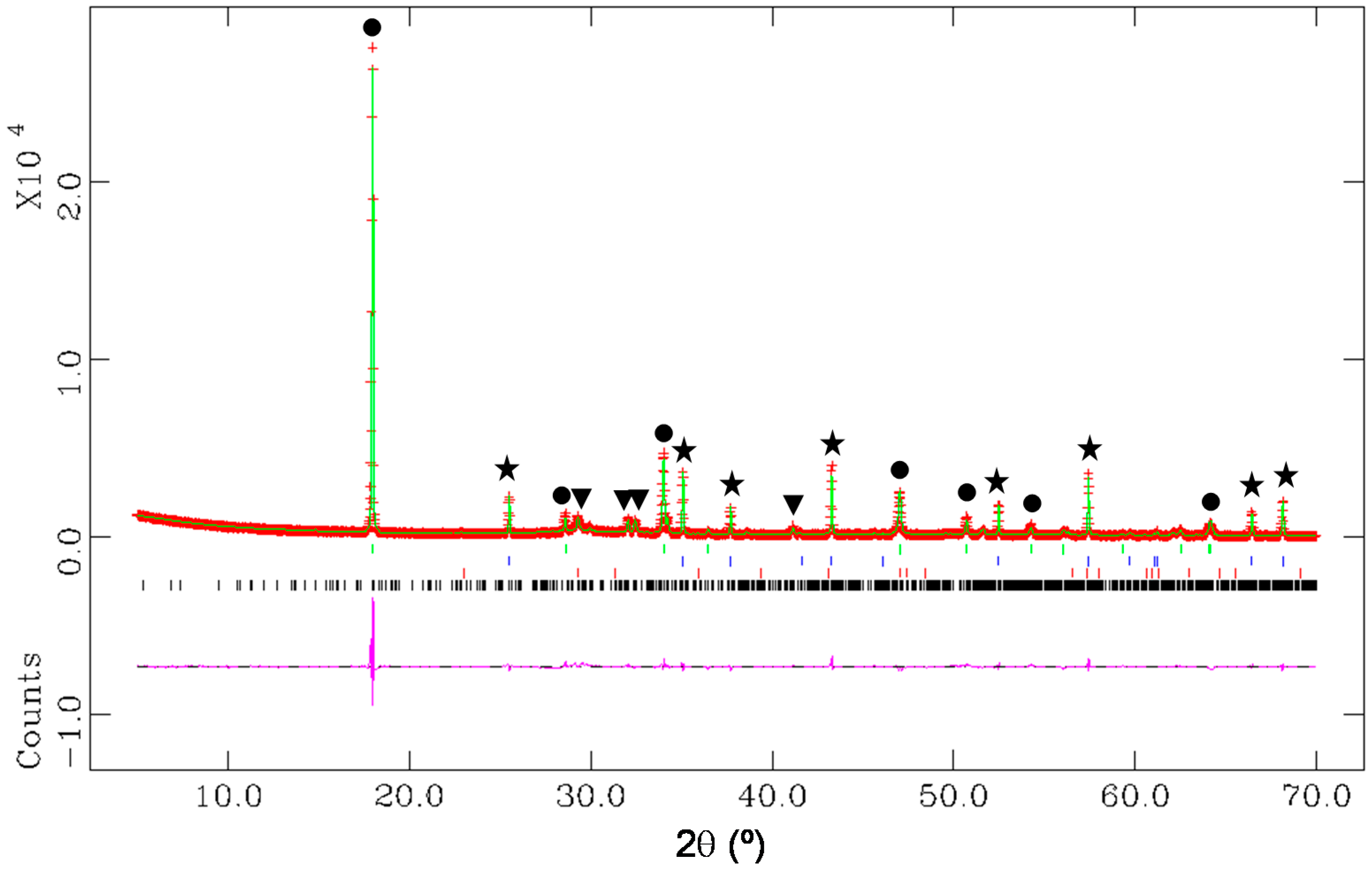
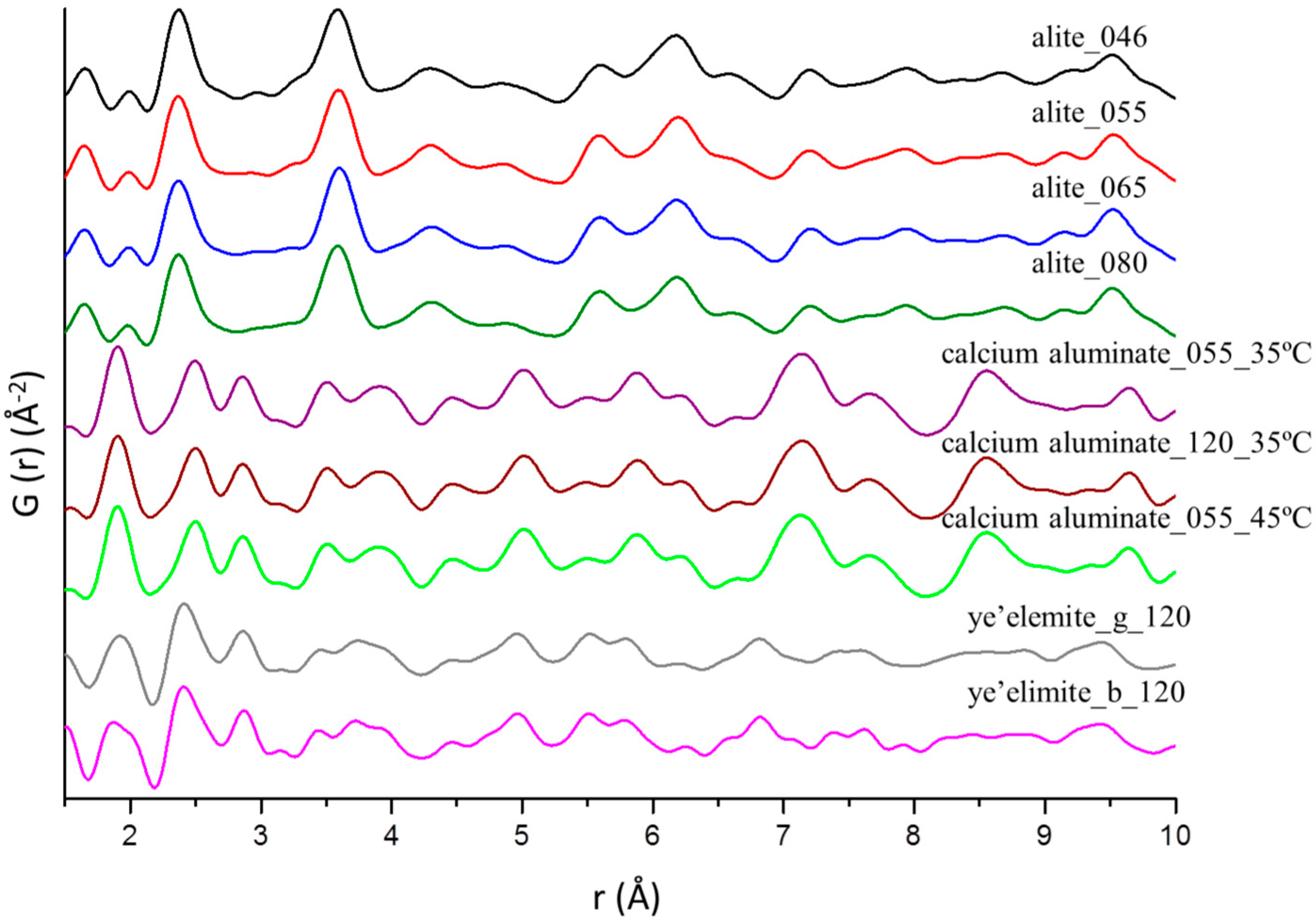
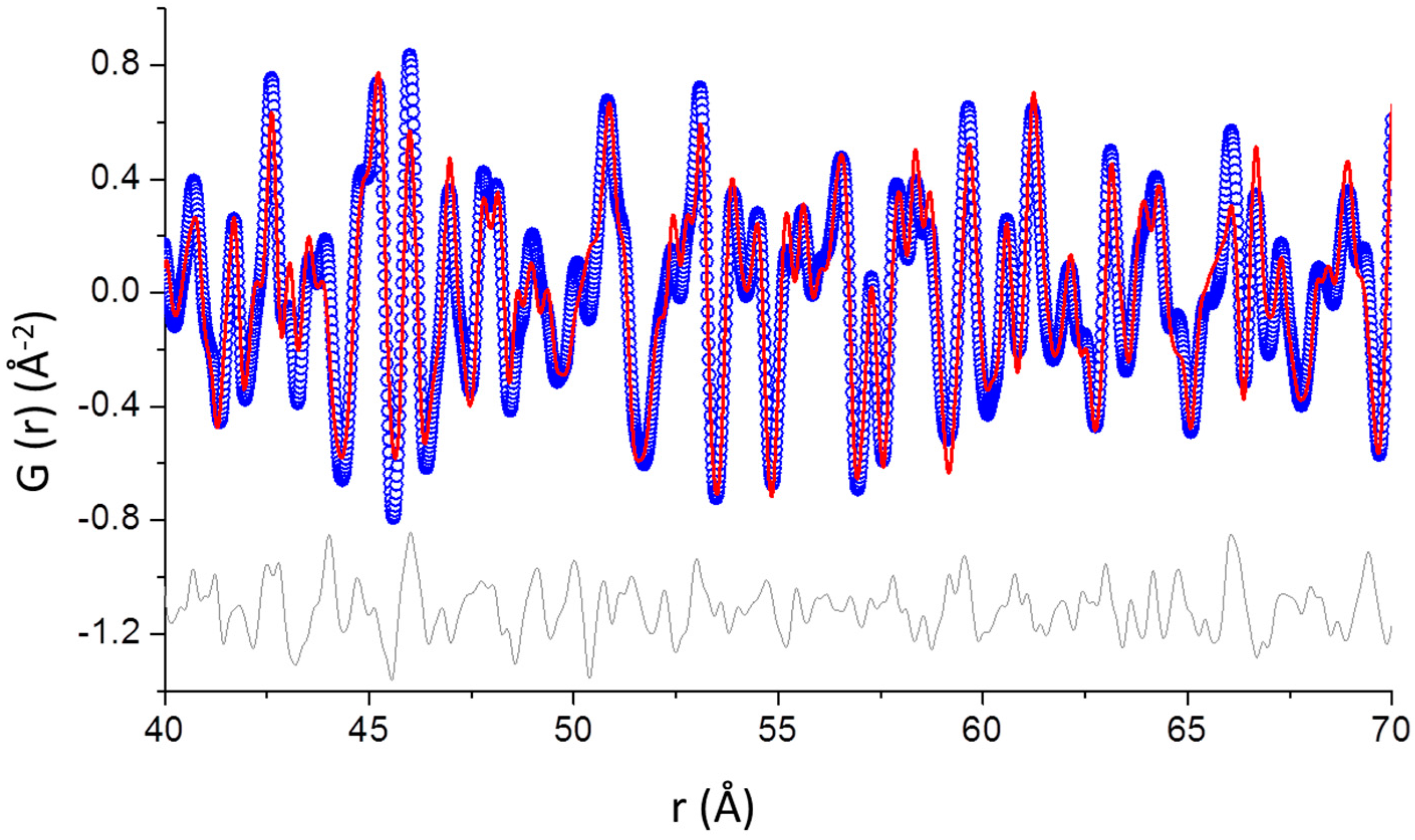
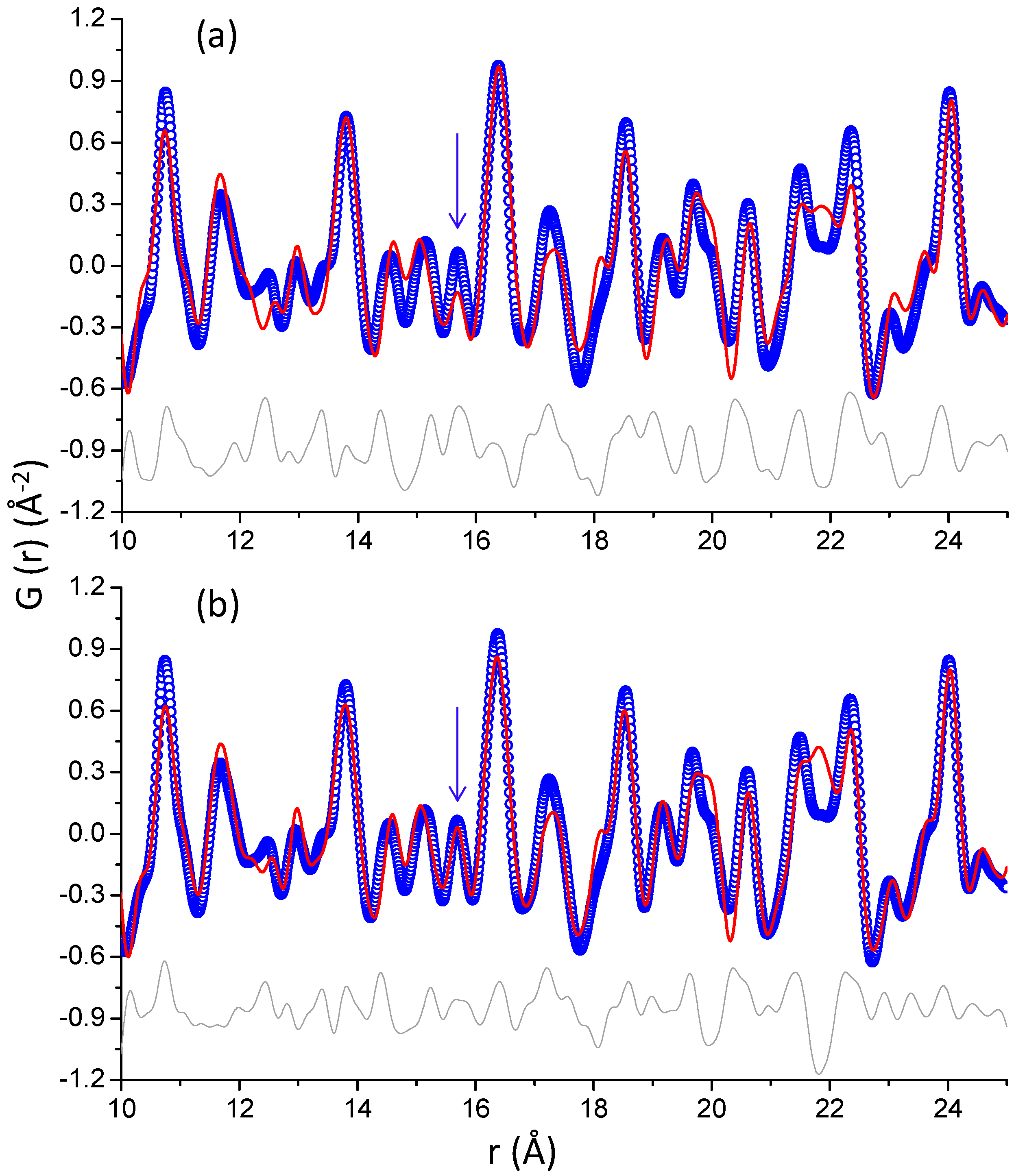
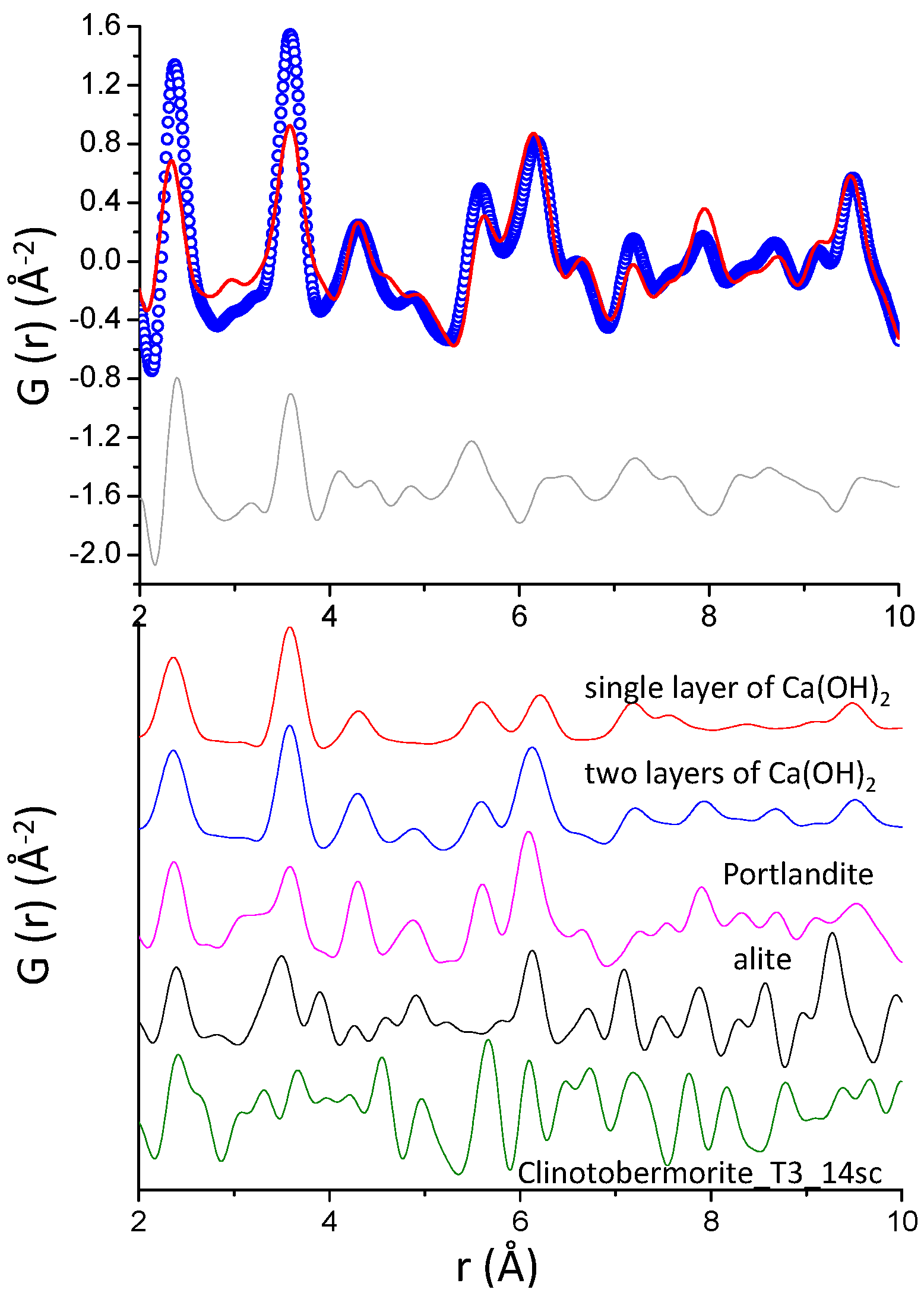

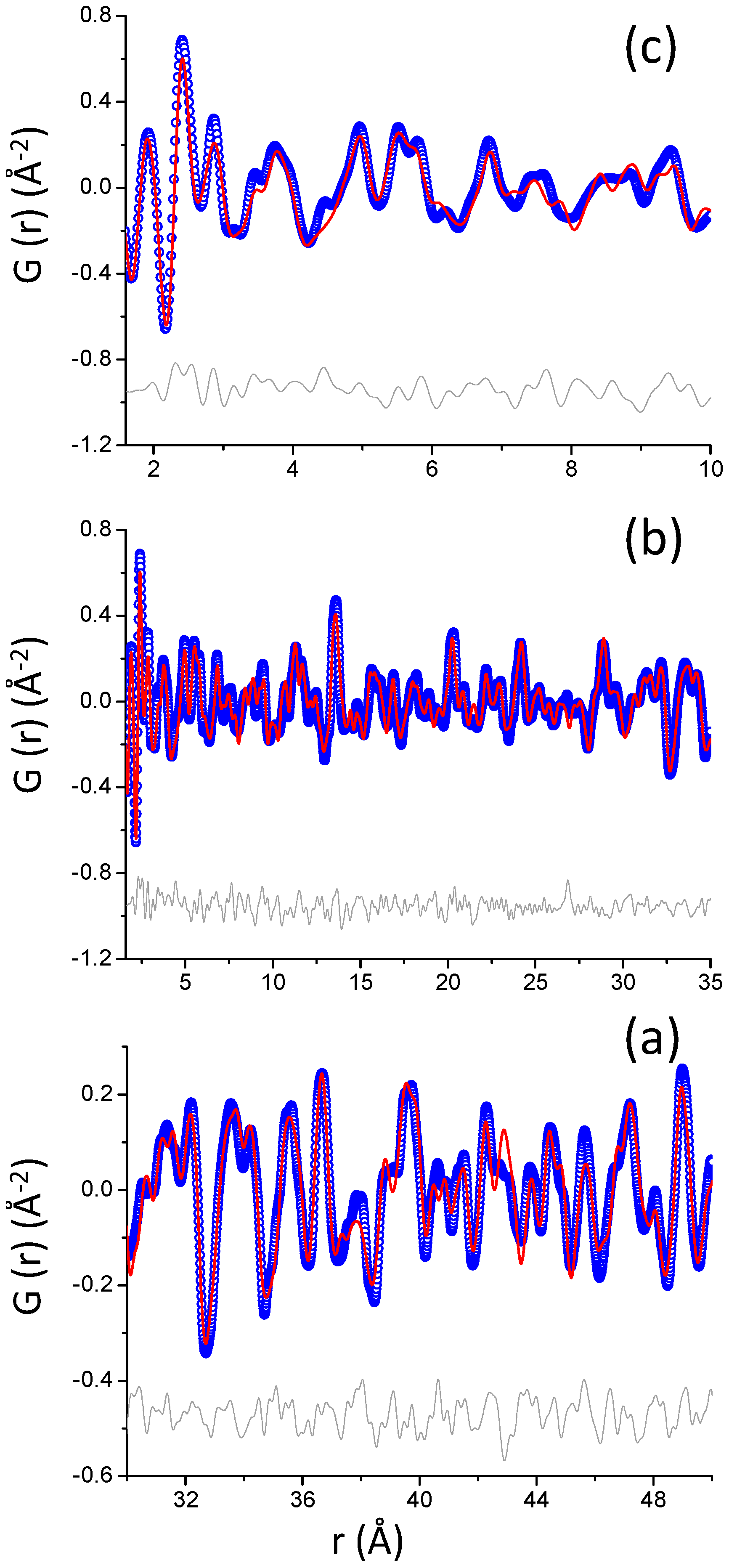
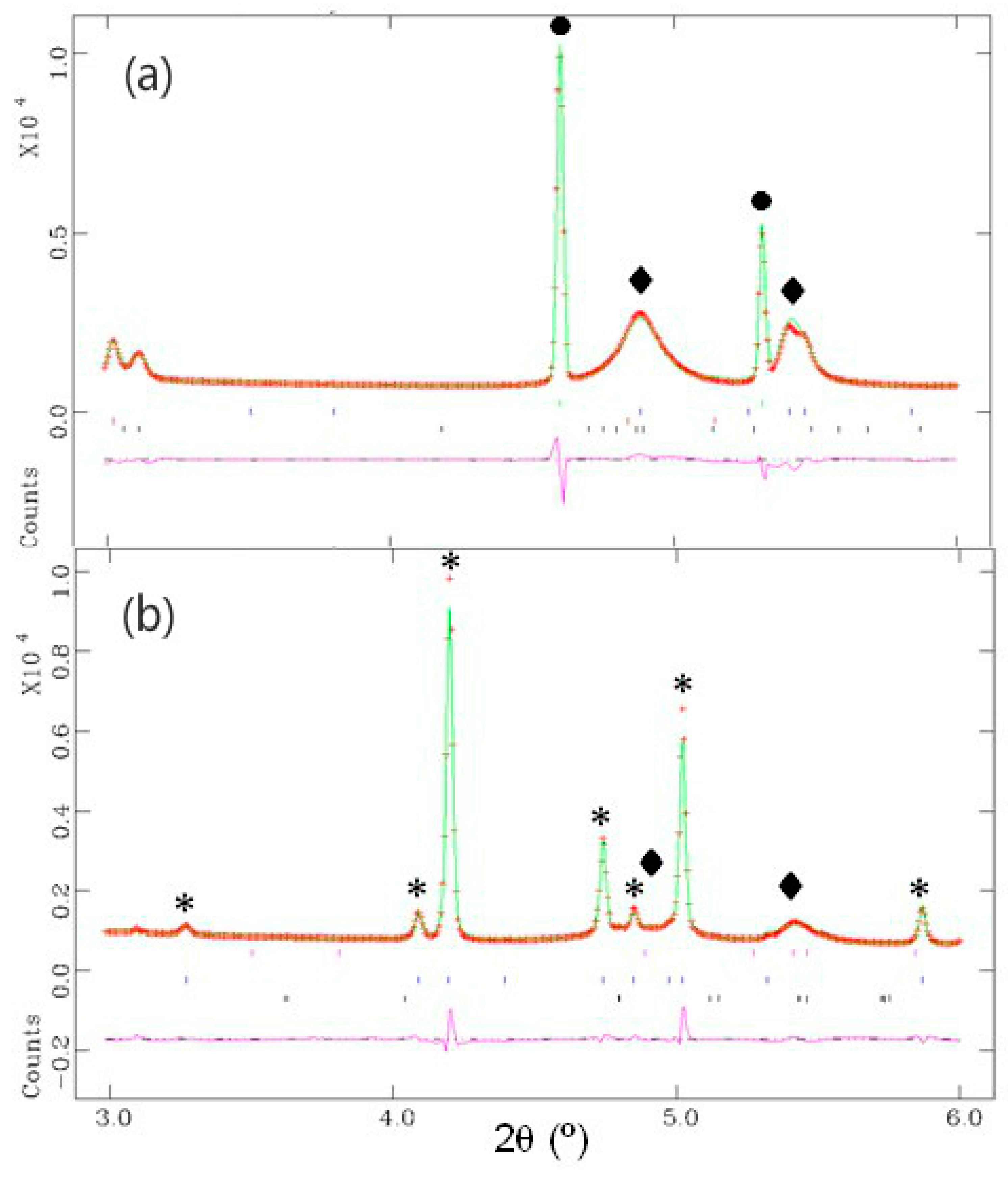
| Phase | RW (%) | Ca3SiO5 (wt%) | CaCO3 (wt%) | Cryst-Ca(OH)2 (wt%) | C-S-H (wt%) |
|---|---|---|---|---|---|
| Jennite (t), ICSD #151413 | 33.0 | 20.3 | 1.4 | 34.5 | 43.7 |
| Tobermorite-14 (m), ICSD #152489 | 32.9 | 20.9 | 1.5 | 35.5 | 42.2 |
| Tobermorite-11 (o), ICSD #92941 | 30.3 | 18.6 | 1.3 | 31.6 | 48.5 |
| Tobermorite-11 (m), ICSD #87690 | 30.5 | 17.6 | 1.2 | 29.8 | 51.4 |
| Tobermorite-11 (o), ICSD #100405 | 29.9 | 19.7 | 1.4 | 33.5 | 45.5 |
| Clinotobermorite (m), ICSD #90036 | 28.8 | 13.8 | 1.0 | 23.4 | 61.9 |
| Clinotobermorite (t), ICSD #90034 | 28.5 | 14.1 | 1.0 | 23.9 | 61.0 |
| Clinotobermorite (m), T5_14sc* | 29.2 | 15.4 | 1.1 | 26.2 | 57.4 |
| Clinotobermorite (m), T5_11sc* | 30.4 | 17.8 | 1.2 | 30.2 | 50.8 |
| Clinotobermorite (m), T3_14sc* | 28.5 | 16.0 | 1.1 | 27.1 | 55.8 |
| Sample | RW (%) | Hydrogarnet (wt%) | Hemicarbonate (wt%) | Al(OH)3 gel (wt%) | Spdiameter (nm) |
|---|---|---|---|---|---|
| CA_055_35 °C | 17.5 | 45.6 | 2.9 | 51.5 | 6.2 |
| CA_120_35 °C | 20.6 | 48.1 | 4.6 | 47.3 | 5.0 |
| CA_055_45 °C | 20.2 | 48.7 | 2.4 | 48.9 | 6.6 |
| Sample | RW (%) | Ettringite (wt%) | Al(OH)3 gel (wt%) | Spdiameter (nm) |
|---|---|---|---|---|
| ye’elimite-gypsum paste | 27.5 | 61.3 | 38.7 | 2.8 |
| ye’elimite-bassanite paste | 28.4 | 59.9 | 40.1 | 2.6 |
© 2017 by the authors. Licensee MDPI, Basel, Switzerland. This article is an open access article distributed under the terms and conditions of the Creative Commons Attribution (CC BY) license (http://creativecommons.org/licenses/by/4.0/).
Share and Cite
Cuesta, A.; Zea-Garcia, J.D.; Londono-Zuluaga, D.; De la Torre, A.G.; Santacruz, I.; Vallcorba, O.; Aranda, M.A.G. Synchrotron Radiation Pair Distribution Function Analysis of Gels in Cements. Crystals 2017, 7, 317. https://doi.org/10.3390/cryst7100317
Cuesta A, Zea-Garcia JD, Londono-Zuluaga D, De la Torre AG, Santacruz I, Vallcorba O, Aranda MAG. Synchrotron Radiation Pair Distribution Function Analysis of Gels in Cements. Crystals. 2017; 7(10):317. https://doi.org/10.3390/cryst7100317
Chicago/Turabian StyleCuesta, Ana, Jesus D. Zea-Garcia, Diana Londono-Zuluaga, Angeles G. De la Torre, Isabel Santacruz, Oriol Vallcorba, and Miguel A.G. Aranda. 2017. "Synchrotron Radiation Pair Distribution Function Analysis of Gels in Cements" Crystals 7, no. 10: 317. https://doi.org/10.3390/cryst7100317







